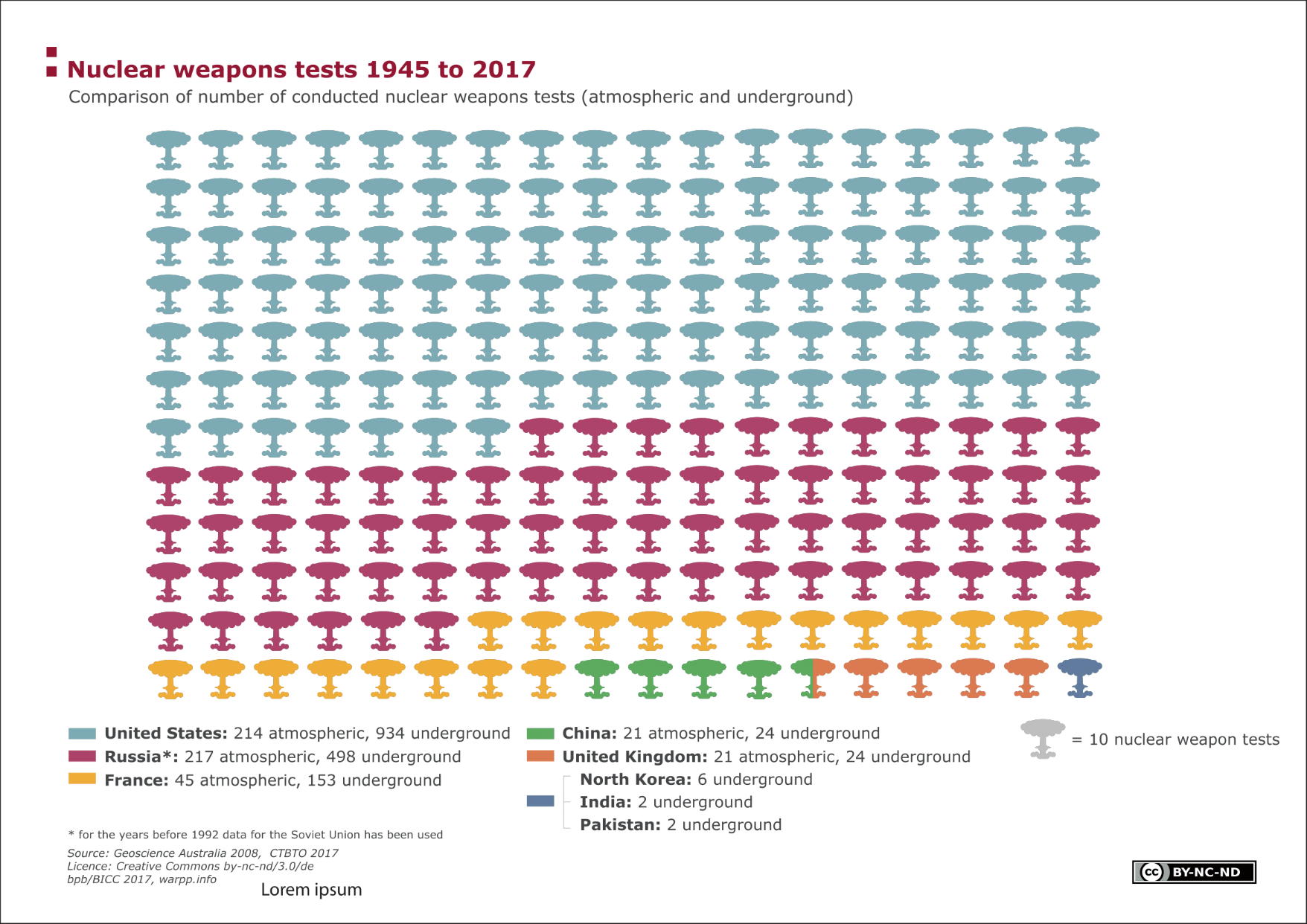Nuclear weapons tests 1945 to 2017

The illustration shows all subterranean tests and tests above ground with nuclear explosive devices between 1945 and 2017 of a country. All nuclear tests that have been carried out are colour coded according to countries, hence making a comparison between countries easier. A mushroom cloud in the illustration stands for 10 nuclear weapons tests.
Facts
From 1945 to 2017, the United States have carried out the most tests with nuclear weapons: 1,148 in total, of which 934 were subterranean, 214 above ground. Russia is in second place with regard to the total number of nuclear weapons tests, with 715 tests of which 498 subterranean and 217 in the atmosphere. This shows that these two countries carried out about 86 percent of worldwide nuclear weapons tests.
With the United States having been the first, in 1945 the test was followed by the only drop of one atom bomb on Hiroshima and one on Nagasaki towards the end of the Second World War. North Korea carried out the most recent nuclear weapons test in 2017. All in all, 2,161 nuclear explosions (above or below ground, atmospherically or under water) were triggered by man. This number is partially based on the measurements obtained from the seismic activities and any nuclear radiation caused by the tests as not all countries report their nuclear tests.
This illustration is mainly based on Geoscience Australia's data base on nuclear explosions and has been complemented by data from the US Department of Energy. The latest nuclear tests by North Korea in 2013, 2016 and 2017 have been added to this collection of data. Subcritical nuclear tests, that is tests that have not triggered a chain reaction and that have not released radiation, are not listed.
Terms, notes on methodology or reading aids
Nuclear weapons are weapons of mass destruction that derive their destructive force from nuclear reactions, the fission or fusion of the atom. To produce a nuclear weapon, either highly enriched uranium or separated plutonium is needed. Depending on the bomb size and the location of the explosion (in the air or on the ground), one single nuclear bomb can contaminate and/or destroy large areas and kill vast amounts of people. So-called radiological dispersal devices ('dirty bombs') do not fall under the category of nuclear weapons, as their destructive power stems from conventional explosives that scatter radiological material without causing either fusion or fission.
Nuclear weapons tests are conducted in the course of research on nuclear weapons and the behaviour of nuclear material under special circumstances. One has to differentiate between critical and sub-critical tests. The first test, requires the minimum quantity necessary for a nuclear chain reaction (also called critical mass). The following explosion first results in an immense thermal heat wave, followed by a destructive blast wave and a nuclear radiation wave that scorches or contaminates living beings with radiation. Subcritical tests, however, only use a small amount of weapons-grade, fissile material that is combined with (25 to 250 kg) explosives and triggered below the ground (about 300m depth). There is no nuclear chain reaction and no measurable release of radiation. It is not clear whether subcritical nuclear tests are nuclear tests according to the NPT and therefore banned. The United States and Russia continue to carry out subcritical tests and argue that they have to investigate the behaviour of ageing nuclear weapons.
Data sources
Geoscience Australia Geoscience Australia is an Australian public sector organization that deals with the use and management of resources, sustainable energy, tourism, environmental management and the connected well-being of the population. In 2008, it published a nuclear explosions database that documents all explosions in the years 1945 to 2007.
Geoscience Australia - Database
CTBTO (Comprehensive Nuclear-Test-Ban Treaty Organization) Founded in 1997 and located in Vienna, the CTBTO's main task is to promote the Treaty and to make first development and the further development of nuclear weapons more difficult by operating a worldwide monitoring system. A global net of sensors serves as surveillance mechanism; furthermore it intends to carry out on-site inspections after the Treaty has actually come into force. The organization can only fulfil its mission completely when the 44 states have ratified Annex 2 of the Treaty; so far, only 41 states have signed and 36 have ratified the Treaty.





